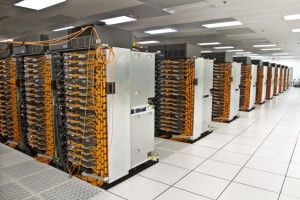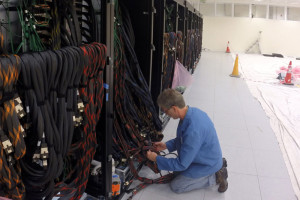
This morning the list of the Top 500 fastest, most powerful global supercomputers was released. The list is compiled with results from the LINPACK supercomputing performance benchmark twice each year, once in summer at the annual International Supercomputing Conference (ISC) in Germany and again each November at the Supercomputing Conference (SC).
While you can find a great deal of in depth coverage and analysis about top-ranked and other high performance computing (HPC) systems here at The Next Platform, we wanted to deliver a more basic overview of the performance, power consumption, application details to help put the results in some context. If you’re looking for more depth on the architectural and trends front, please move over to the Top 500 analysis piece we published in conjunction with the list announcement.
Here are the results from this morning’s announcement in order of top performance…
 #1: Tianhe-2 – Chinese National University of Defense Technology
#1: Tianhe-2 – Chinese National University of Defense Technology
Tianhe-2 (Milky Way-2), a system developed by China’s National University of Defense Technology (NUDT) and deployed at the National Supercomputer Center in Guangzho, China remains the No. 1 system with 33.86 petaflop/s (Pflop/s) on the Linpack benchmark.
The system currently has 16,000 nodes, each with two Intel Xeon Ivy Bridge processors and three Xeon Phi processors for a combined total of 3,120,000 computing cores. It features a number of Chinese-developed components, including the TH Express-2 interconnect network, front-end processors, operating system and software tools. The Tianhe-2 uses the Kylin Linux operating system. The power consumption of Tianhe-2 while running Linpack was 17.8 MW.
 #2 Titan – Oak Ridge National Laboratory, U.S.A.
#2 Titan – Oak Ridge National Laboratory, U.S.A.
Titan, a Cray XK7 system installed at the Department of Energy’s Oak Ridge National Laboratory remains the number two system. It is an extensive upgrade to the former top-ranked Jaguar supercomputer, a process that started in 2011 and was complete in 2012. Titan held the top spot on the Top 500 in November 2012 before the Tianhe machine was benchmarked.
It achieved 17.59 Pflop/s on the Linpack benchmark using 261,632 of its NVIDIA K20x accelerator cores. Titan is one of the most energy efficient systems on the list consuming a total of 8.21 MW and delivering 2.143 Gflops/W. Titan’s successor, the Summit supercomputer, will sport an entirely different architecture (NVIDIA/IBM/Mellanox) when it appears at Oak Ridge sometime in 2018 and is likely to also appear in the top five (if we were to make a guess—few saw Tianhe-1 or its successor coming, to be fair).
 #3 Sequoia – Lawrence Livermore National Laboratory, U.S.A.
#3 Sequoia – Lawrence Livermore National Laboratory, U.S.A.
Sequoia is the highest performance sibling in a family of IBM BlueGene supercomputers, which are no longer being supported and will eventually begin to drop off the Top 500 list. Sequoia is one of several older systems on this year’s list (something discussed in more detail here) as it was first delivered in 2011.
Sequoia has achieved 17.17 Pflop/s on the Linpack benchmark using 1,572,864 cores. It was the first supercomputer to pass the 10 petaflops of sustained performance barrier and has enabled breakthroughs in key genomics, climate, astronomy and energy application areas.
 #4 K Computer, RIKEN Advanced Institute for Computational Science, Japan
#4 K Computer, RIKEN Advanced Institute for Computational Science, Japan
Fujitsu’s K computer installed at the RIKEN Advanced Institute for Computational Science (AICS) in Kobe, Japan. This system hit the 10.51 petaflop mark on the Linpack benchmark using 705,024 SPARC64 processing cores.
The K Computer made its initial entry on the Top 500 list in June 2011. It is notable for its unique architecture, featuring the novel Tofu interconnect. This architecture has performed well on other HPC benchmarks, including the new companion metric developed by LINPACK creator and Top 500 co-founder, Jack Dongarra, called HPCG.
 #5 Mira, Argonne National Laboratory, U.S.A.
#5 Mira, Argonne National Laboratory, U.S.A.
 #6 Piz Daint, Swiss National Supercomputing Centre, Switzerland
#6 Piz Daint, Swiss National Supercomputing Centre, Switzerland
At No. 6 is Piz Daint, a Cray XC30 system installed at the Swiss National Supercomputing Centre (CSCS) in Lugano, Switzerland and the most powerful system in Europe.
Piz Daint achieved 6.27 Pflop/s on the Linpack benchmark using 73,808 NVIDIA K20x accelerator cores. Piz Daint is also the most energy efficient systems in the top ten of the Top 500 list, consuming a total of 2.33 MW and delivering 2.7 Gflops/W.
 #7 Shaheen II, King Abdullah University of Science and Technology, Saudi Arabia
#7 Shaheen II, King Abdullah University of Science and Technology, Saudi Arabia
Shaheen II is the only system on the top ten that was installed and put into production in 2015. The machine is a Cray XC40 system that is capable of 5.536 PFlop/s on the LINPACK benchmark using 196,608 Intel Xeon E5-2698v3 cores.
The original Shaheen system was a BlueGene/P supercomputer that was installed by IBM in 2009 at KAUST. In moving to the Cray XC40 system, the site became home to one of the first (public) large-scale users of the Cray DataWarp technology, which can be used as a burst buffer and to boost overall I/O.
#8 Stampede, Texas Advanced Computing Center, U.S.A.
Stampede, a Dell PowerEdge C8220 system installed at the Texas Advanced Computing Center of the University of Texas, Austin. It also uses Intel Xeon Phi processors to achieve its 5.17 Pflop/s.
Each Stampede node is like a beefy desktop machine. With high-performance processors, RAM, and storage, Stampede combines high-end versions of familiar components to push the envelope of scientific computations.
#9 Juqueen, Forschungszentrum Juelich, Germany
The second system in Europe, this is yet another BlueGene machine from IBM in the top tier of supercomputers. The BlueGene/Q system called JUQEEN is installed at the Forschungszentrum Juelich in Germany and is listed with 5.01 Pflop/s.
#10 Vulcan, Lawrence Livermore National Laboratory, U.S.A.
No. 10 is taken by Vulcan, another IBM BlueGene/Q system at Lawrence Livermore National Laboratory. It was temporarily combined with the No. 3 system but is now operated independently. It achieved 4.29 Pflop/s.
These are list results as they have come in. For more detailed analysis please read here and stay tuned for our coverage from the International Supercomputing Conference in Frankfurt, Germany this week.
The full list can be found at http://www.top500.org





Be the first to comment